Cohen I.M., Kundu P.K. Fluid Mechanics
Подождите немного. Документ загружается.


612 Geophysical Fluid Dynamics
The vertical component of the Coriolis force, namely −2u cos θ, is generally
negligible compared to the dominant terms in the vertical equation of motion, namely
gρ
/ρ
0
and ρ
−1
0
(∂p
/∂z). Using equations (14.6) and (14.7), the equations of motion
(14.2) reduce to
Du
Dt
− fv=−
1
ρ
0
∂p
∂x
+ ν
H
∂
2
u
∂x
2
+
∂
2
u
∂y
2
+ ν
v
∂
2
u
∂z
2
,
Dv
Dt
+ fu=−
1
ρ
0
∂p
∂y
+ ν
H
∂
2
v
∂x
2
+
∂
2
v
∂y
2
+ ν
v
∂
2
v
∂z
2
,
Dw
Dt
=−
1
ρ
0
∂p
∂z
−
gρ
ρ
0
+ ν
H
∂
2
w
∂x
2
+
∂
2
w
∂y
2
+ ν
v
∂
2
w
∂z
2
.
(14.9)
These are the equations of motion for a thin shell on a rotating earth. Note that only
the vertical component of the earth’s angular velocity appears as a consequence of the
flatness of the fluid trajectories.
f -Plane Model
The Coriolis parameter f = 2 sin θ varies with latitude θ . However, we shall see
later that this variation is important only for phenomena having very long time scales
(several weeks) or very long length scales (thousands of kilometers). For many pur-
poses we can assume f to be a constant, say f
0
= 2 sin θ
0
, where θ
0
is the central
latitude of the region under study. A model using a constant Coriolis parameter is
called an f-plane model.
β-Plane Model
The variation of f with latitude can be approximately represented by expanding f in
a Taylor series about the central latitude θ
0
:
f = f
0
+ βy, (14.10)
where we defined
β ≡
df
dy
θ
0
=
df
dθ
dθ
dy
θ
0
=
2 cos θ
0
R
.
Here, we have used f = 2 sin θ and dθ/dy = 1/R, where the radius of the earth is
nearly
R = 6371 km.
A model that takes into account the variation of the Coriolis parameter in the simplified
form f = f
0
+ βy, with β as constant, is called a β-plane model.

5. Geostrophic Flow 613
5. Geostrophic Flow
Consider quasi-steady large-scale motions in the atmosphere or the ocean, away from
boundaries. For these flows an excellent approximation for the horizontal equilibrium
is a balance between the Coriolis force and the pressure gradient:
−fv=−
1
ρ
0
∂p
∂x
,
fu=−
1
ρ
0
∂p
∂y
.
(14.11)
Here we have neglected the nonlinear acceleration terms, which are of order U
2
/L,
in comparison to the Coriolis force ∼fU (U is the horizontal velocity scale, and L
is the horizontal length scale.) The ratio of the nonlinear term to the Coriolis term is
called the Rossby number :
Rossby number =
Nonlinear acceleration
Coriolis force
∼
U
2
/L
fU
=
U
fL
= Ro.
For a typical atmospheric value of U ∼ 10 m/s, f ∼ 10
−4
s
−1
, and L ∼ 1000 km,
the Rossby number turns out to be 0.1. The Rossby number is even smaller for many
flows in the ocean, so that the neglect of nonlinear terms is justified for many flows.
The balance of forces represented by equation (14.11), in which the horizontal
pressure gradients are balanced by Coriolis forces, is called a geostrophic balance.In
such a system the velocity distribution can be determined from a measured distribu-
tion of the pressure field. The geostrophic equilibrium breaks down near the equator
(within a latitude belt of ±3
◦
), where f becomes small. It also breaks down if the
frictional effects or unsteadiness become important.
Velocities in a geostrophic flow are perpendicular to the horizontal pressure gra-
dient. This is because equation (14.11) implies that v
•
∇p = 0, i.e.,...
(iu + jv)
•
∇p =
1
ρ
0
f
−i
∂p
∂y
+ j
∂p
∂x
•
i
∂p
∂x
+ j
∂p
∂y
= 0.
Thus, the horizontal velocity is along, and not across, the lines of constant pressure.
If f is regarded as constant, then the geostrophic balance (14.11) shows that p/fρ
0
can be regarded as a streamfunction. The isobars on a weather map are therefore
nearly the streamlines of the flow.
Figure 14.4 shows the geostrophic flow around low and high pressure centers
in the northern hemisphere. Here the Coriolis force acts to the right of the velocity
vector. This requires the flow to be counterclockwise (viewed from above) around
a low pressure region and clockwise around a high pressure region. The sense of
circulation is opposite in the southern hemisphere, where the Coriolis force acts to
the left of the velocity vector. (Frictional forces become important at lower levels in
the atmosphere and result in a flow partially across the isobars. This will be discussed
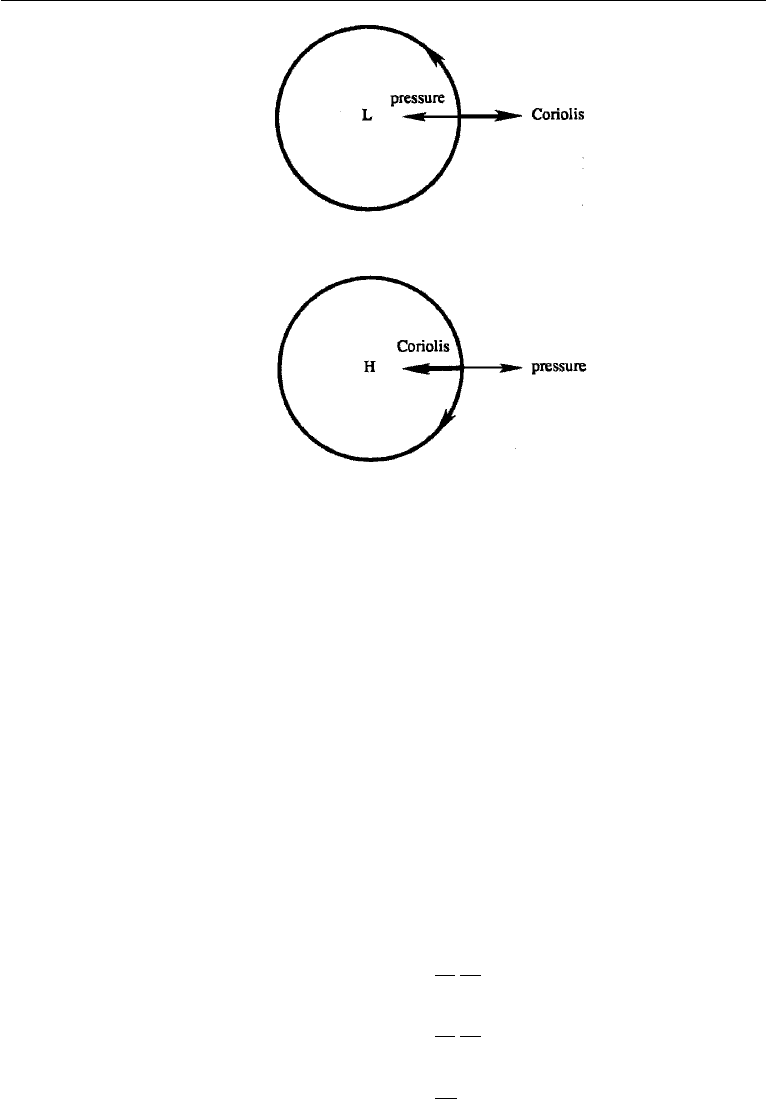
614 Geophysical Fluid Dynamics
Figure 14.4 Geostrophic flow around low and high pressure centers. The pressure force (−∇p)is
indicated by a thin arrow, and the Coriolis force is indicated by a thick arrow.
in Section 7, where we will see that the flow around a low pressure center spirals
inward due to frictional effects.)
The flow along isobars at first surprises a reader unfamiliar with the effects
of the Coriolis force. A question commonly asked is: How is such a motion set up?
A typical manner of establishment of such a flow is as follows. Consider a horizontally
converging flow in the surface layer of the ocean. The convergent flow sets up the
sea surface in the form of a gentle “hill,” with the sea surface dropping away from
the center of the hill. A fluid particle starting to move down the “hill” is deflected to
the right in the northern hemisphere, and a steady state is reached when the particle
finally moves along the isobars.
Thermal Wind
In the presence of a horizontal gradient of density, the geostrophic velocity develops
a vertical shear. This is easy to demonstrate from an analysis of the geostrophic and
hydrostatic balance
−fv =−
1
ρ
0
∂p
∂x
, (14.12)
fu=−
1
ρ
0
∂p
∂y
, (14.13)
0 =−
∂p
∂z
− gρ . (14.14)

5. Geostrophic Flow 615
Eliminating p between equations (14.12) and (14.14), and also between equations
(14.13) and (14.14), we obtain, respectively,
∂v
∂z
=−
g
ρ
0
f
∂ρ
∂x
,
∂u
∂z
=
g
ρ
0
f
∂ρ
∂y
.
(14.15)
Meteorologists call these the thermal wind equations because they give the verti-
cal variation of wind from measurements of horizontal temperature gradients. The
thermal wind is a baroclinic phenomenon, because the surfaces of constant p and ρ
do not coincide.
Taylor–Proudman Theorem
A striking phenomenon occurs in the geostrophic flow of a homogeneous fluid. It can
only be observed in a laboratory experiment because stratification effects cannot be
avoided in natural flows. Consider then a laboratory experiment in which a tank of
fluid is steadily rotated at a high angular speed and a solid body is moved slowly
along the bottom of the tank. The purpose of making large and the movement of
the solid body slow is to make the Coriolis force much larger than the acceleration
terms, which must be made negligible for geostrophic equilibrium. Away from the
frictional effects of boundaries, the balance is therefore geostrophic in the horizontal
and hydrostatic in the vertical:
−2v =−
1
ρ
∂p
∂x
, (14.16)
2u =−
1
ρ
∂p
∂y
, (14.17)
0 =−
1
ρ
∂p
∂z
− g. (14.18)
It is useful to define an Ekman number as the ratio of viscous to Coriolis forces
(per unit volume):
Ekman number =
viscous force
Coriolis force
=
ρνU/L
2
ρf U
=
ν
fL
2
= E.
Under the circumstances already described here, both Ro and E are small.
Elimination of p by cross differentiation between the horizontal momentum
equations gives
2
∂v
∂y
+
∂u
∂x
= 0.

616 Geophysical Fluid Dynamics
Using the continuity equation, this gives
∂w
∂z
= 0. (14.19)
Also, differentiating equations (14.16) and (14.17) with respect to z, and using
equation (14.18), we obtain
∂v
∂z
=
∂u
∂z
= 0. (14.20)
Equations (14.19) and (14.20) show that
∂u
∂z
= 0,
(14.21)
showing that the velocity vector cannot vary in the direction of . In other words,
steady slow motions in a rotating, homogeneous, inviscid fluid are two dimensional.
This is the Taylor–Proudman theorem, first derived by Proudman in 1916 and demon-
strated experimentally by Taylor soon afterwards.
In Taylor’s experiment, a tank was made to rotate as a solid body, and a small
cylinder was slowly dragged along the bottom of the tank (Figure 14.5). Dye was
introduced from point A above the cylinder and directly ahead of it. In a nonrotat-
ing fluid the water would pass over the top of the moving cylinder. In the rotating
experiment, however, the dye divides at a point S, as if it had been blocked by an
upward extension of the cylinder, and flows around this imaginary cylinder, called
the Taylor column. Dye released from a point B within the Taylor column remained
there and moved with the cylinder. The conclusion was that the flow outside the
upward extension of the cylinder is the same as if the cylinder extended across the
entire water depth and that a column of water directly above the cylinder moves with
it. The motion is two dimensional, although the solid body does not extend across
the entire water depth. Taylor did a second experiment, in which he dragged a solid
body parallel to the axis of rotation. In accordance with ∂w/∂z = 0, he observed
that a column of fluid is pushed ahead. The lateral velocity components u and v
were zero. In both of these experiments, there are shear layers at the edge of the
Taylor column.
In summary, Taylor’s experiment established the following striking fact for steady
inviscid motion of homogeneous fluid in a strongly rotating system: Bodies moving
either parallel or perpendicular to the axis of rotation carry along with their motion
a so-called Taylor column of fluid, oriented parallel to the axis. The phenomenon is
analogous to the horizontal blocking caused by a solid body (say a mountain) in a
strongly stratified system, shown in Figure 7.33.
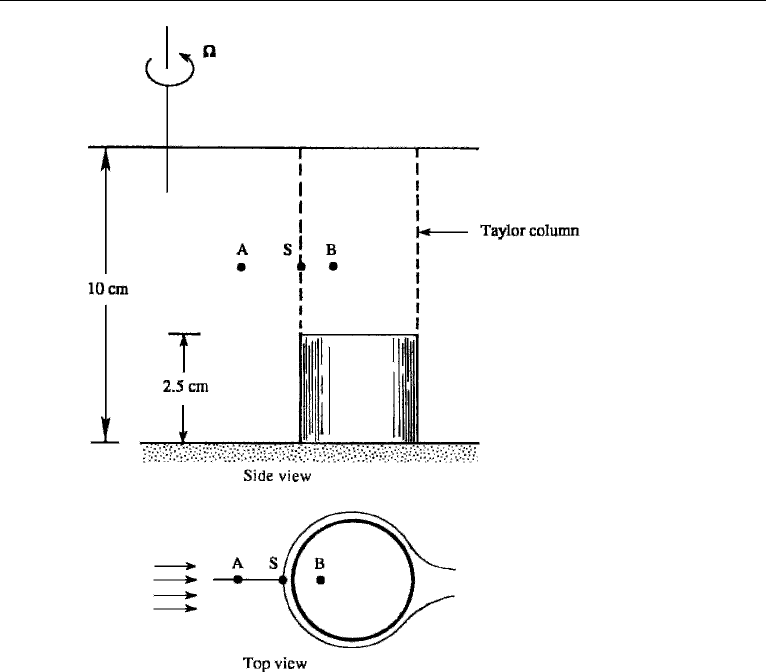
6. Ekman Layer at a Free Surface 617
Figure 14.5 Taylor’s experiment in a strongly rotating flow of a homogeneous fluid.
6. Ekman Layer at a Free Surface
In the preceding section, we discussed a steady linear inviscid motion expected to be
valid away from frictional boundary layers. We shall now examine the motion within
frictional layers over horizontal surfaces. In viscous flows unaffected by Coriolis
forces and pressure gradients, the only term which can balance the viscous force is
either the time derivative ∂u/∂t or the advection u
•
∇u. The balance of ∂u/∂t and
the viscous force gives rise to a viscous layer whose thickness increases with time,
as in the suddenly accelerated plate discussed in Chapter 9, Section 7. The balance
of u
•
∇u and the viscous force give rise to a viscous layer whose thickness increases
in the direction of flow, as in the boundary layer over a semi-infinite plate discussed
in Chapter 10, Sections 5 and 6. In a rotating flow, however, we can have a balance
between the Coriolis and the viscous forces, and the thickness of the viscous layer
can be invariant in time and space. Two examples of such layers are given in this and
the following sections.

618 Geophysical Fluid Dynamics
Consider first the case of a frictional layer near the free surface of the ocean,
which is acted on by a wind stress τ in the x-direction. We shall not consider how
the flow adjusts to the steady state but examine only the steady solution. We shall
assume that the horizontal pressure gradients are zero and that the field is horizontally
homogeneous. From equation (14.9), the horizontal equations of motion are
−fv = ν
v
d
2
u
dz
2
, (14.22)
fu= ν
v
d
2
v
dz
2
. (14.23)
Taking the z-axis vertically upward from the surface of the ocean, the boundary
conditions are
ρν
v
du
dz
= τ at z = 0, (14.24)
dv
dz
= 0atz = 0 , (14.25)
u, v → 0asz →−∞. (14.26)
Multiplying equation (14.23) by i =
√
−1 and adding equation (14.22), we obtain
d
2
V
dz
2
=
if
ν
v
V, (14.27)
where we have defined the “complex velocity”
V ≡ u + iv.
The solution of equation (14.27) is
V = Ae
(1+i)z/δ
+ Be
−(1+i)z/δ
, (14.28)
where we have defined
δ ≡
2 ν
v
f
.
(14.29)
We shall see shortly that δ is the thickness of the Ekman layer. The constant B
is zero because the field must remain finite as z →−∞. The surface boundary
conditions (14.24) and (14.25) can be combined as ρν
v
(dV /dz) = τ at z = 0, from
which equation (14.28) gives
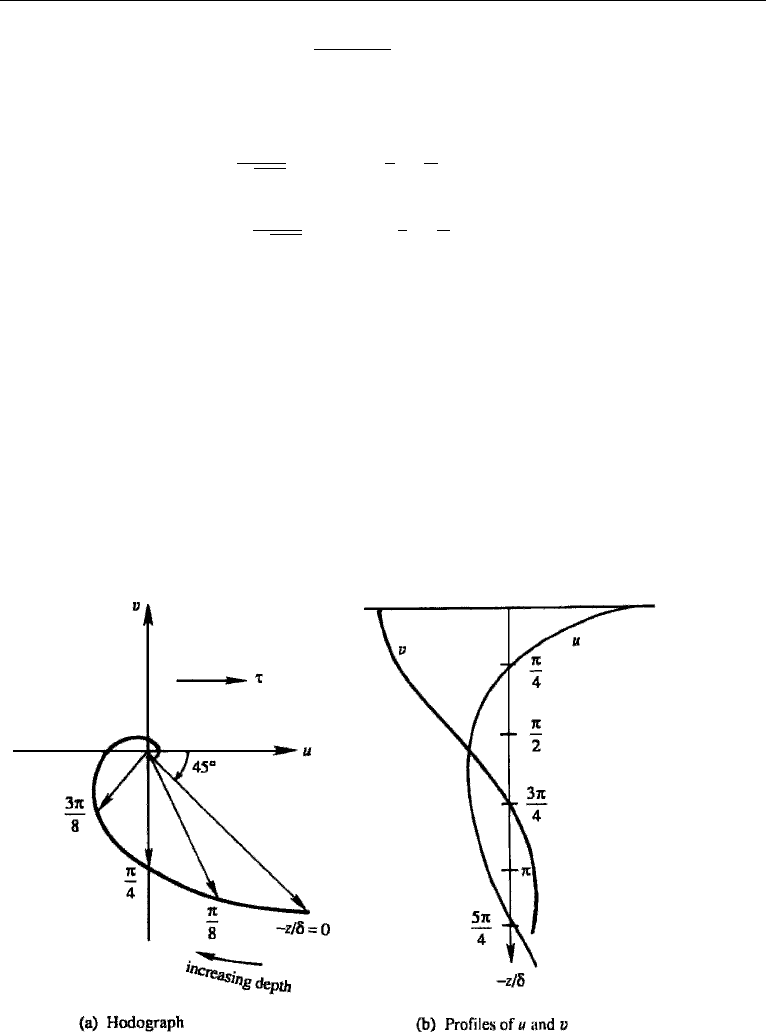
6. Ekman Layer at a Free Surface 619
A =
τδ(1 − i)
2ρν
v
.
Substitution of this into equation (14.28) gives the velocity components
u =
τ/ρ
√
fν
v
e
z/δ
cos
−
z
δ
+
π
4
,
v =−
τ/ρ
√
fν
v
e
z/δ
sin
−
z
δ
+
π
4
.
The Swedish oceanographer Ekman worked out this solution in 1905. The solu-
tion is shown in Figure 14.6 for the case of the northern hemisphere, in which f
is positive. The velocities at various depths are plotted in Figure 14.6a, where each
arrow represents the velocity vector at a certain depth. Such a plot of v vs u is some-
times called a “hodograph” plot. The vertical distributions of u and v are shown
in Figure 14.6b. The hodograph shows that the surface velocity is deflected 45
◦
to
the right of the applied wind stress. (In the southern hemisphere the deflection is to
the left of the surface stress.) The velocity vector rotates clockwise (looking down)
with depth, and the magnitude exponentially decays with an e-folding scale of δ,
which is called the Ekman layer thickness. The tips of the velocity vector at various
depths form a spiral, called the Ekman spiral.
Figure 14.6 Ekman layer at a free surface. The left panel shows velocity at various depths; values of
−z/δ are indicated along the curve traced out by the tip of the velocity vectors. The right panel shows
vertical distributions of u and v.
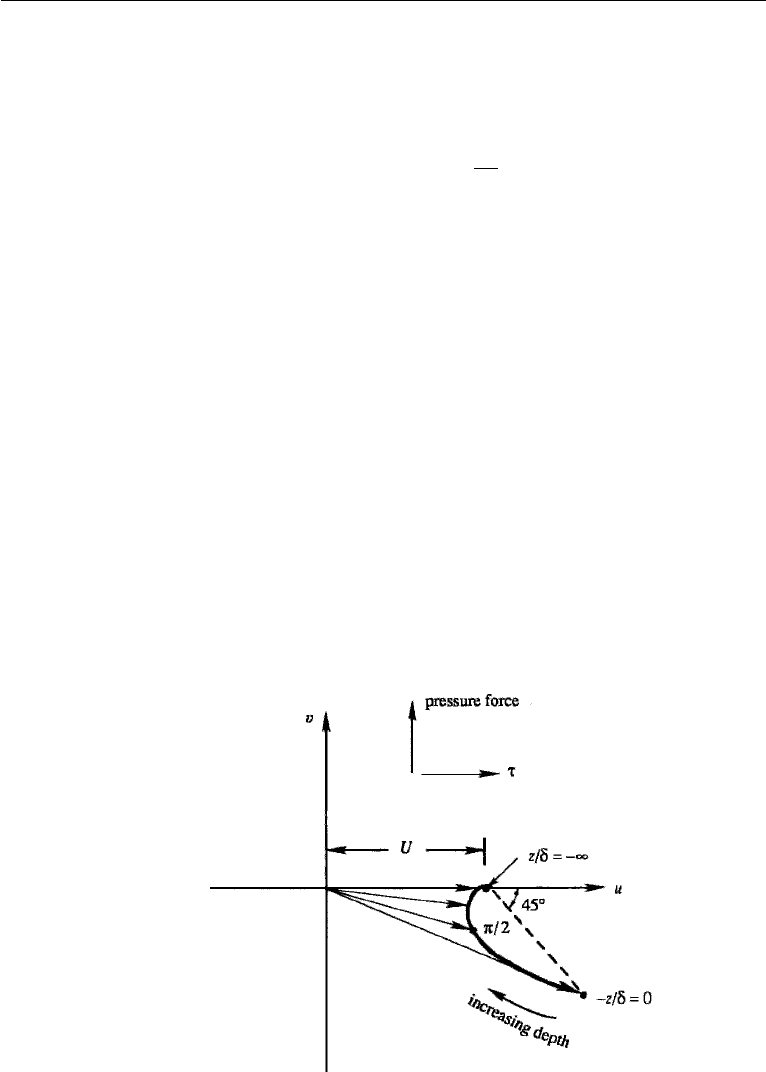
620 Geophysical Fluid Dynamics
The components of the volume transport in the Ekman layer are
0
−∞
udz = 0,
0
−∞
vdz=−
τ
ρf
.
(14.30)
This shows that the net transport is to the right of the applied stress and is independent
of ν
v
. In fact, the result
vdz=−τ/fρ follows directly from a vertical integration of
the equation of motion in the form −ρf v = d(stress)/dz, so that the result does not
depend on the eddy viscosity assumption. The fact that the transport is to the right of
the applied stress makes sense, because then the net (depth-integrated) Coriolis force,
directed to the right of the depth-integrated transport, can balance the wind stress.
The horizontal uniformity assumed in the solution is not a serious limitation.
Since Ekman layers near the ocean surface have a thickness (∼50 m) much smaller
than the scale of horizontal variation (L>100 km), the solution is still locally appli-
cable. The absence of horizontal pressure gradient assumed here can also be relaxed
easily. Because of the thinness of the layer, any imposed horizontal pressure gradient
remains constant across the layer. The presence of a horizontal pressure gradient
merely adds a depth-independent geostrophic velocity to the Ekman solution. Suppose
the sea surface slopes down to the north, so that there is a pressure force acting north-
ward throughout the Ekman layer and below (Figure 14.7). This means that at the
bottom of the Ekman layer (z/δ →−∞) there is a geostrophic velocity U to the
right of the pressure force. The surface Ekman spiral forced by the wind stress joins
smoothly to this geostrophic velocity as z/δ →−∞.
Figure 14.7 Ekman layer at a free surface in the presence of a pressure gradient. The geostrophic velocity
forced by the pressure gradient is U .
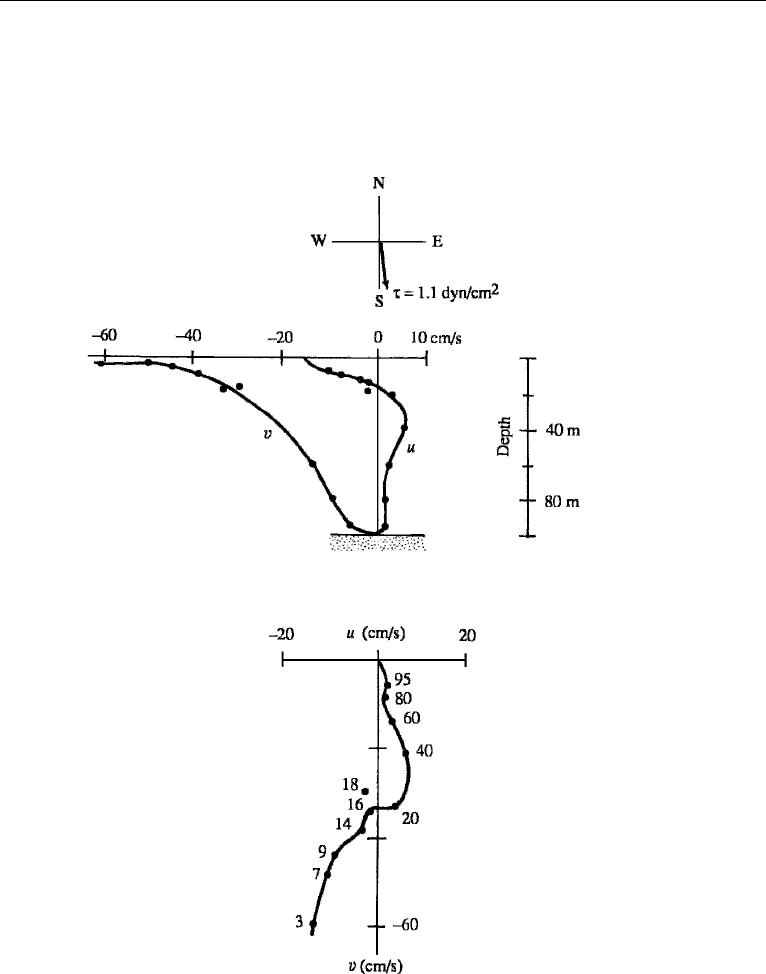
6. Ekman Layer at a Free Surface 621
Pure Ekman spirals are not observed in the surface layer of the ocean, mainly
because the assumptions of constant eddy viscosity and steadiness are particularly
restrictive. When the flow is averaged over a few days, however, several instances
have been found in which the current does look like a spiral. One such example is
shown in Figure 14.8.
Figure 14.8 An observed velocity distribution near the coast of Oregon. Velocity is averaged over 7 days.
Wind stress had a magnitude of 1.1 dyn/cm
2
and was directed nearly southward, as indicated at the top of
the figure. The upper panel shows vertical distributions of u and v, and the lower panel shows the hodograph
in which depths are indicated in meters. The hodograph is similar to that of a surface Ekman layer (of
depth 16 m) lying over the bottom Ekman layer (extending from a depth of 16 m to the ocean bottom).
P. Kundu, in Bottom Tubulence, J. C. J. Nihoul, ed., Elsevier, 1977 and reprinted with the permission of
Jacques C. J. Nihoul.
